 Nobles and Nobility in Medieval Europe
Nobles and Nobility in Medieval Europe Introduction: Concepts, Origins, Transformations
Published online by Cambridge University Press: 25 October 2017
Summary
‘Indeed, I am not “sprung from an ancient line of kings”, wrote Thomas Becket in 1166, rising to the taunt that he had been raised from poverty through the king's favour, ‘nevertheless, I prefer to be a man in whom nobility of mind creates nobility than one in whom nobility of birth degenerates.’ This response neatly encapsulates the two principal elements in the construction of nobility in the Middle Ages: distinction based on birth, blood, and lineage and distinction of character and intellect – and expresses the recurrent theme that the one could and often did exist without the other. By the time that Thomas Becket (himself very much a parvenu, born of mercantile parents with some knightly affiliations, but not knightly status) was embroiled in his great dispute with Henry II (who was affronted when Herbert of Bosham pointed out that he was not the son of a king!), the broad shape of the European nobility had come into being and was poised to consolidate itself even further. Evidence of its self-consciousness, wealth, and status is everywhere to be seen: celebrated in vernacular chansons, reflected in the newly created and hugely popular Arthurian literature, emblazoned on tombs and personal seals, and its members commemorated as founders and patrons of churches, monasteries, and hospitals. They were notable and noted in chronicles and annals; they divided the lordship of lands and peoples among themselves and shared the government of realms with kings and emperors. But who were they, these ‘nobiles’, where did they come from, how did they acquire the precise power and status which they enjoyed, and how did they then manage to hold on to that power and transfer it, sometimes through many generations, to later descendants who would bear their names? How, indeed, was the concept of ‘noble’ and ‘nobility’ constructed? – for what we see is not merely the acquisition and maintenance of landed wealth, but the creation of an ideology which justified their superior status and attributed to them a dynastic right to rule based on descent from noble ancestors.
- Type
- Chapter
- Information
- Nobles and Nobility in Medieval EuropeConcepts, Origins, Transformations (King's College London 1998), pp. 1 - 14Publisher: Boydell & BrewerPrint publication year: 2000


